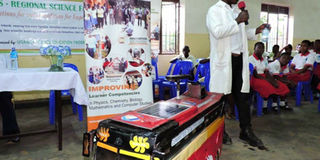Technical schools hub for innovation

Godfrey Ssekabira Wasswa presents the prototype of a metro bus tram during the Uganda Science Education Programme last year. The bus, he hopes, will ease transport in Uganda. COURTSEY PHOTO
What you need to know:
- Twenty five-year-old Godfrey Ssekabira Wasswa exhibited hunger for innovation in secondary school. Luckily, he joined a vocational training institute and his dreams are coming to light after he designed a metro bus tram transport system aimed at easing transport in Uganda.
Godfrey Ssekabira Wasswa, from Kalungu District, is one of the multi skilled technicians in the country. The 25-year-old is a certified automotive technician from Lugogo Vocational Training Institute and an aircraft refuelling systems technician with one of the oil companies at Entebbe International Airport. In this field, he is one of the onsite certified Ugandans by world aviation fuelling equipment manufactures such as Titan, Zodiac, Eaton, Elaflex and Parker, having received his training from France.
In addition, Ssekabira is a carpenter and an innovator with his Bus Tram project. “As a young innovator, I got an idea of designing a metro bus tram transport system in Uganda way back in 2011 when I was completing Senior Four from St Stephen’s College, Bajja, with the hope of solving various problems affecting our transport industry but to also get involved in technological advancements taking place in Uganda,” he says.
The youngster’s perception was that he was not supposed to wait until university to start involving his mind and mental capabilities in innovations aimed at development in the country, but instead take up initiatives using the limited resources available to come up with solutions for problems affecting our country.
The start
“I started making my dream a reality at St Charles Lwanga, Kasasa, during A-Level. I managed to come up with a hard paper frame model with a control timer for stopping and starting the transmission motor, opening and closing of access doors, generation of warning alarms made from copper plates, DC motor and a Panadol empty box. Its operation was complex and inefficient, but it introduced me to a more advanced electronic system,” Ssekabira recalls.
This model was presented at USEP National Science Symposium held at Serena in October 2013.
After that exhibition, he got some money that enabled him revise his structure and build another reasonably presentable model that was made of aluminum with advanced electronic controls that can identify stages, darkness, detect obstacles among other features.
One thing Ssekabira vividly recalls is that in A-Level, he invested in innovation work so much that while his fellow students were in class learning, he was hanging out with local mechanics who taught him some basics on how to better his prototype.
As a result, his Uganda Advanced Certificate of Education results were not the best. He got three points in Physics Economics and Mathematics. His father advised him to repeat but he did not want to. “I decided to join a vocational college instead,” he confesses.
Funding
By the time of his second attempt at the model, Ssekabira had started pursuing his automotive course at Lugogo Vocational Training Institute and due to media stories about his innovation, the managing director of one of the big oil companies in the country got interested in funding him to advance his prototype.
“This model had very many features, which I cannot disclose now, but I was also recruited as an aviation mechanic. The training I did from France opened my mind to the real world of automated systems designing and implementation and it is that knowledge that I am using to build my real working prototype,” he says.
However, he shares a simple hint of what is in store.
“It is a plan of an elevated metro tram rail originating from the railway station headquarters, with a stopover in Nakawa, then connects to Ntinda, but will also have a stopover. It will then connect to Wandegeya and back to the railway headquarters. I am optimistic that this plan can be implemented at a low cost since in its architecture, only a few city buildings will be affected,” Ssekabira says.
Other than this project, Ssekabira does carpentry work in his free time and some of his products are; a fully packed standalone in-house mobile kitchen with features such as on-board fridge, on-board microwave, on-board retractable gas stove with cylinder storage of up 12kgs, and on-board wash sink among other features.
Start ups
Barter your skills. You can use your skills to also train others at a fee.
Parental support. Parents can help get you financial help.
Seek a bank loan. Some banks offer soft loans for those starting business.
Explore youth funds from NGOs. Some NGOs give startups to youth.




